Weekly round-up: 30 July - 05 August 2014
There was rather more of a west/east divide across the country this week as much of the east coast remained bathed in sunshine (although temperatures were down a little on the past couple of weeks) whilst the west side of the UK and also much of Ireland saw low double digit temperatures, brisk winds from the northwest and plenty of rain put a (literal) dampener on things.
The Atlantic based weather systems meant that there’d be a general churning up in the seabird world, the first of the autumn and records most certainly started to reflect that across the review period and more seem certain to be on the way before the weekend ahead is out.
…but it wasn’t all seabirds. There were new birds across any number of family groups and Shetland threw in a fascinating early August surprise as the week concluded.
That ole Swinhoe’s Storm-petrel just can’t help itself can it? Another summer week passes by on Fair Isle and along comes another trip in to the nets on one of the Observatory’s petrel ringing evenings, during the wee small hours of July 31st and in to the first day of the new month.
Such nocturnal meanderings around the tapes (we’re up to eight for the season so far) seems almost obligatory now and a fair few people have taken the Swinhoe’s challenge, headed north and thrown their collective hats in to the metaphorical ringing ring ~ and it seems that everyone to date has headed home happy with in-hand views of a truly awesome seabird.
Well it beats doing the day job doesn’t it?
…and talking of awesome seabirds…
Last year it was July 31st that will be, for two Cork birders, forever remembered as “The Day There Were Three”. Despite being a nigh-on annual visitor to the waters of Britain and Ireland, Fea’s(-type) Petrels remain a massive prize on any seawatch and when Ciairan Cronin and Colin Barton logged an incredible trio off Galley Head last summer, that prize seemed to have a whole bunch of bells on (though the Bulwer’s there the following day took the quality up a notch or two…).
This summer has been a modest one to date for Pterodromas, single Fea’s-types noted on consecutive days (at sea off the coast of East Yorkshire and then passing County Down) on July 13th and 14th and now we have a third for July and the first two for August 2014.
The first of the week saw Galley Head getting in on the act again, if only because this particular individual was noted at sea, from a boat around eight miles off the Cork headland, on 30th. Then, on 3rd, a man from Cork (seabird photographer supreme Ronan McLaughlin) managed to score a Fea’s-type off Malin Head (Co. Donegal) on the evening of 3rd, heading west in northwest winds gusting up to 25 knots. Once accepted, Ronan’s bird will become only the second record for the county ~ to date the only Donegal record was seen from Melmore Head on August 29th 2002.
As the final night of the review period drew to a close, the third Fea’s(-type) Petrel of the week was noted from Porthgwarra (Cornwall) on the evening of 5th. To date there have been five accepted records there, including the famous bird of Peter Harrison’s in August 1989 with the most recent bird on the record books being one logged between August 30th-September 2nd 2009 ~ though some observers present over the period remain adamant that it was three birds, and not one that were involved…
It is Cork though which has a most enviable record for this species (assuming none have been Zino’s).
Until the end of 2011 there were 34 accepted records from the county (from a grand total of 129 given the thumbs up to the start of 2012) and since then there have been a further four reports from 2012, an incredible nine in 2013 (the July three, three in August, two in September and one in November) and now this week’s bird. It was 40 years ago this September, that the very first Fea’s-type was seen ~ off Cape Clear Island ~ and it seems fitting that Cork still leads the way as the prime county in which to try and encounter this supreme seabird.
Northumberland’s rather dashing adult Stilt Sandpiper at Cresswell Pond NWT remained for a second day (July 30th) but had departed the following day to who knows where…
Fortunately, it lingered long enough for Frank Golding to rattle off some masterful images of this super Stilt.
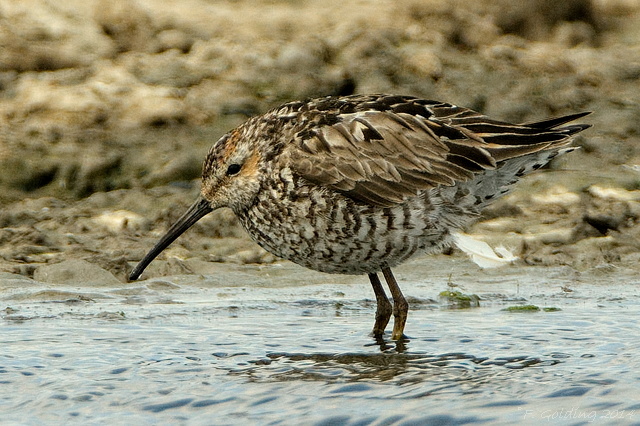
Given the southward bent of these things, it would come as no surprise whatsoever if a birder anywhere between Cleveland, East Yorkshire, Lincolnshire or East Anglia (look out Cambridgeshire…) picked up this particular bird in the next few days.
…let’s see where we get by the end of the review period…
…and this is where we are ~ we’re almost back to Square One as, after a blank three days, the Stilt Sandpiper appeared less than a mile and half away from Cresswell Ponds, popping up at Druridge Pools on 3rd where it was still showing over the following two days (sometimes noted from the Bill Oddie Hide).
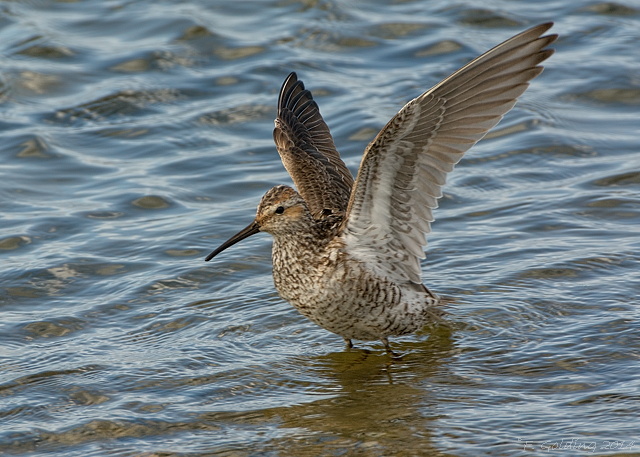
Seemingly right on cue, as was mused upon here amongst last week’s rare words of wisdom, the “on tour” Black-winged Pratincole apparently made some suitable excuses, appearing to have departed the Cambridgeshire Washes and made a beeline for the south coast, appearing at Cuckmere Haven (East Sussex) early on the morning of 30th, flushed from the river bank before last being seen heading west over Seaford and lost to view.
Once given the official nod, this could become the first record for the county of this still-very rare species. As a nearby for instance, neighbouring West Sussex has only one record to date ~ a juvenile seen at Sidlesham Ferry on October 14th 1981.
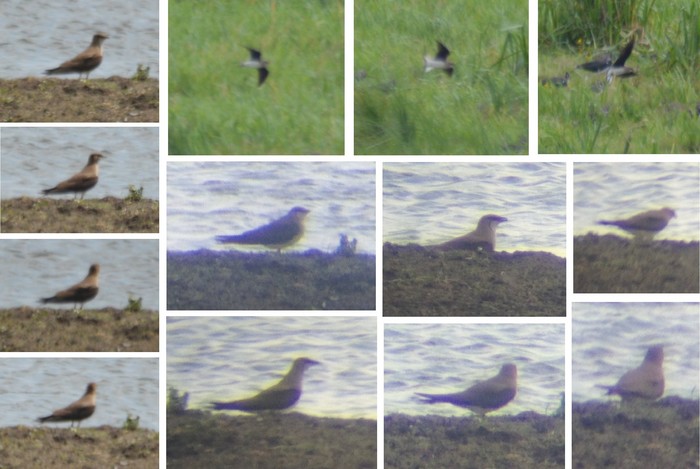
This year’s particularly rangey travelling individual has, through the summer, enabled two counties to potentially join the elite “Three Pratincole” club ~ prior to 2014 just Norfolk, Suffolk, Kent and West Sussex had recorded Oriental Pratincole, Black-winged Pratincole and Collared Pratincole within their boundaries ~ now, thanks to this bird, both Lincolnshire and East Sussex can look to join the party, both records this summer being “1st” records (if both records are accepted of course).
East Sussex could become the seventh county that has been paid a visit by this wanderer, which has clocked up a few miles since entering UK airspace (with a few on the near-continent there’s a chance that any pratincole in East Sussex may not actually have been our friend Rover ~ a fact perhaps emphasised by the return a third appearance in the fens on August 2nd-5th).
Let’s try and bring the scores-on-the-doors bang-up-to-date (expect to see the same thing repeated in the BBRC rarities report in 14 months time…).
Northumberland ~ June 12th
Cleveland ~ June 13th
Durham ~ July 5th-6th
Northumberland (again) ~ July 7th
Lincolnshire ~ July 14th
Norfolk ~ July 15th-17th
Cambridgeshire ~ July 19th-20th and 25th-27th
East Sussex ~ July 30th
Cambridgeshire ~ August 2nd-5th
Anymore for anymore?
Birders enjoying a weekend of pelagic excursions from Scilly were treated to a single Wilson’s Storm-petrel on Saturday’s outing (2nd), along with two species of “big shears” ~ seven Cory’s and a single Great along with an awesome-looking Leatherback Turtle ~ captured for posterity by Joe Pender.
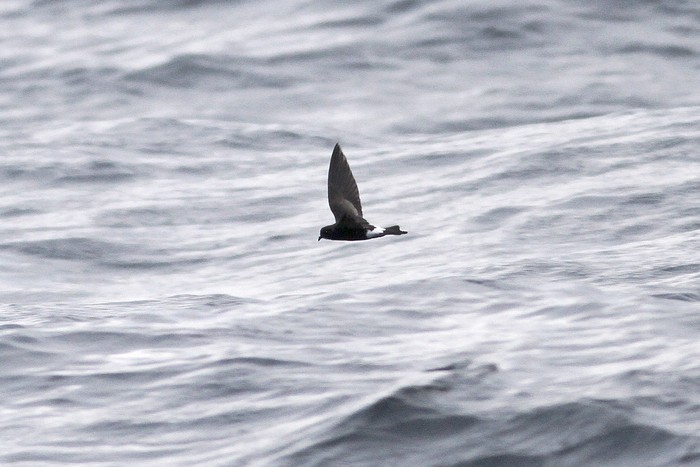
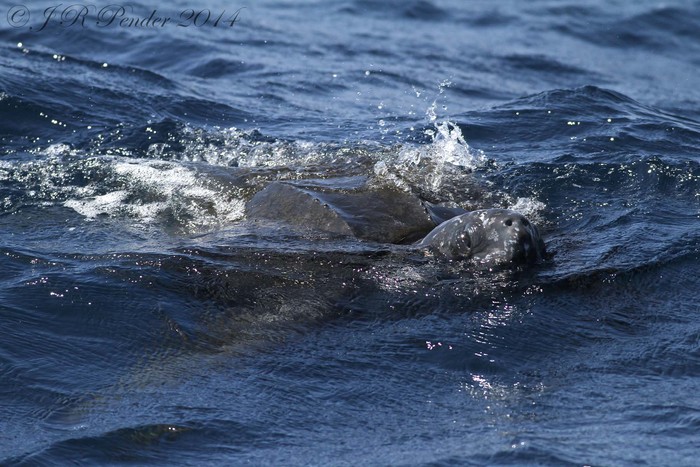
The Birder’s Special on 3rd yielded 14 Cory’s Shearwaters and three Greats while a single Cory’s and 10 Great Shearwaters were noted from a Scilly boat trip on 1st (with a single Great noted from another trip the previous day).
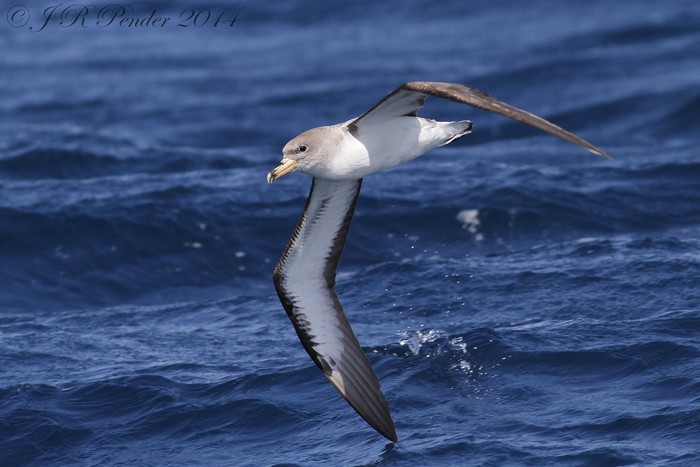
Further Cory’s Shearwater elsewhere this week included singles on the 1st of the month off Porthgwarra (Cornwall) and Strumble Head (Pembrokeshire) and two off Portland Bill (Dorset) on 2nd. There were a handful more Great Shearwaters reported ~ around Cornwall, a single was seen from a boat off Land’s End on 30th, four passed Porthgwarra on 1st and further loners in Falmouth Bay on 2nd and again off Porthgwarra on 3rd (along with five Cory’s). Mayo birders logged another single Great on 3rd, passing Annagh Head with Donegal seeing one each passing Fanad Head and Malin Head the same day.
A favourable Atlantic weather system on August 4th produced a decent selection of always appreciated seabirds from a few southwestern locations.
Leading the way, a lumpy-bumpy pelagic off Scilly which yielded a Wilson’s Storm-petrel, 80 Great Shearwaters and 25 Cory’s Shearwaters. The evening trip to the Cornish mainland produced five Cory’s and three Greats from the M.V. Scillonian III while a single Cory’s Shearwater and two Greats were seen from Porthgwarra. Off the coast of the County Cork, at least 40 Great Shearwaters were seen from a pelagic trip some 15 miles off Galley Head.
The final day of the roundup period (5th) saw Devon register eight Great Shearwaters trundling past Berry Head (and 16 Balearics) with another off Start Point. Further down in to west Cornwall, 13 Great Shearwater and three Cory’s Shearwaters were seen from Porthgwarra, three Greats were seen from St. Agnes (Scilly) with a further 21 (along with two Cory’s) were seen from Old Head of Kinsale (Co. Cork). There’ll be more and more as the weekend draws close…
By the end of the weekend 50 Balearic Shearwaters had been recorded, all bar two along the south coast. A dozen were logged off Portland while Devon’s Prawle Point clocked up 16 on 1st. A further seven were seen elsewhere in the latter county with nine off Porthgwarra up until 2nd. There were also singles in Dumfries & Galloway and counties Antrim and Mayo.
Two single Leach’s Storm-petrels were reported through the week ~ both at sites that featured last week, and both birds this week trapped overnight on 31st ~ on Farne Islands (Northumberland) and Fair Isle (Shetland).
An adult Long-tailed Skua was logged from Holland Haven CP (Essex) on 2nd and a second adult was present at Pagham Harbour LNR (West Sussex) from 2nd-5th (identified from photos on 4th). A busy seabird day on 5th saw two adults noted off the coast of Highland over the Burma Bank. Pomarine Skuas managed four singles ~ one each for Porthgwarra on 1st, Powillimount (Dumfries & Galloway) on 2nd and 3rd and one at Spurn (East Yorkshire) on 3rd.
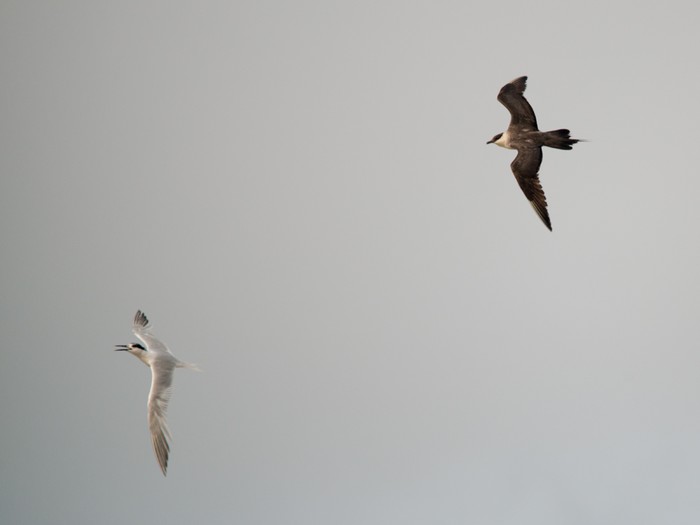
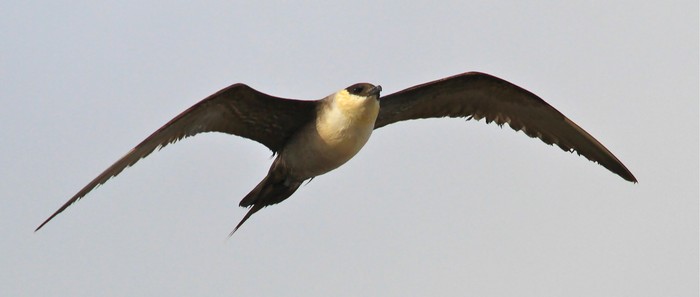
Finally, in the waters off the coast of Skye, three Sabine’s Gulls were seen on a boat trip some five miles out from Staffin on 1st.
In north Norfolk, a cracking juvenile Purple Heron was found along the Iron Road, between Salthouse and Cley during the morning of 1st, quickly relocating to the reedbed on the east side of the famed East Bank soon afterwards before an afternoon relocation to the Cley NWT main reedbed.
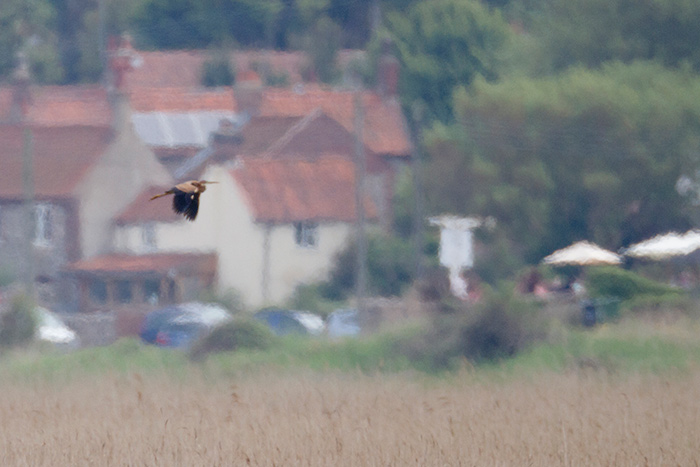
The bird lingered quietly within the swathe of marsh until just after 8pm ~ taking flight across the reserve and, after a couple of suitable circuits, heading off west on the inland side of Blakeney Point. Tracked for the next 10 to 15 minutes as it continued across the saltings, nudging itself first to the southwest, then due south, seemingly not knowing where to go, the youngster eventually tacked back due east and headed toward the north end of Blakeney Freshes. Half an hour later it flew back on to Cley, spooking a Caspian Gull or two in the process, and pitched on to the side of Billy’s Clump. Present there ‘til dark, there was no sign the following day ~ the fascinating manoeuvres witnessed the night before presumably some sort of dress rehearsal for the up, up and away…
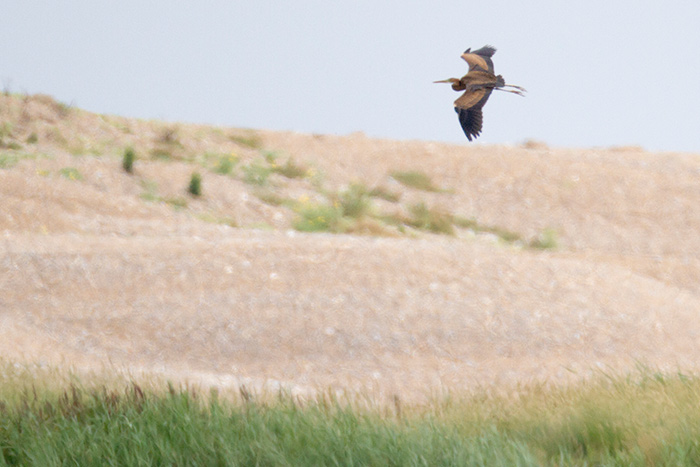
Another Norfolk juvenile Purple Heron was seen at Rockland Broad on 5th with others found on private land in East Sussex on 3rd and a young bird was also reported near North Curry (Somerset) the same day. Warwickshire’s second-summer Night Heron remained at Seeswood Pool throughout the week.
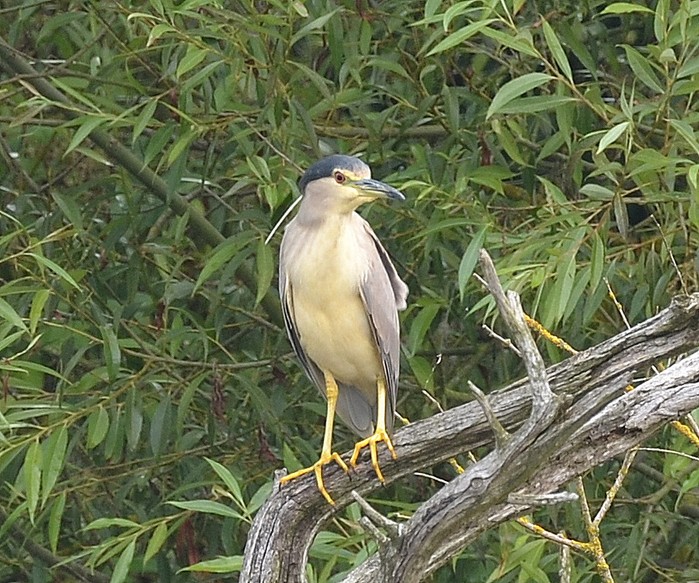
The Gloucestershire Cattle Egrets went from two to three birds on 2nd ~ largely still present in the area around Frampton-upon-Severn ~ and further birds were found at Sidlesham (West Sussex) from 1st-5th and at Susworth (Lincolnshire) on 3rd, while over 30Great White Egrets were well spread around England (with a single for Wales).
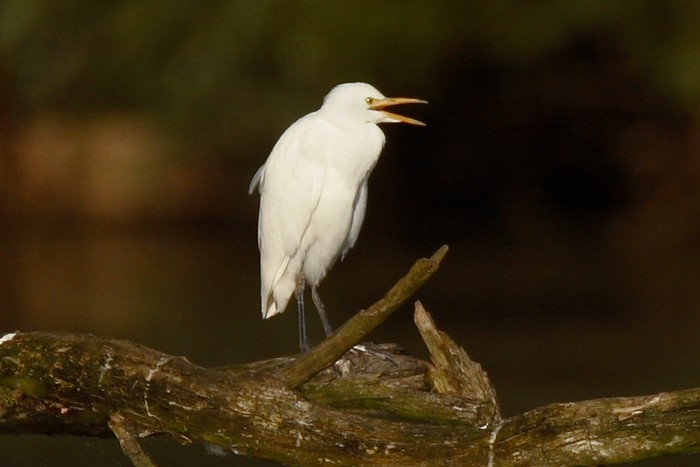
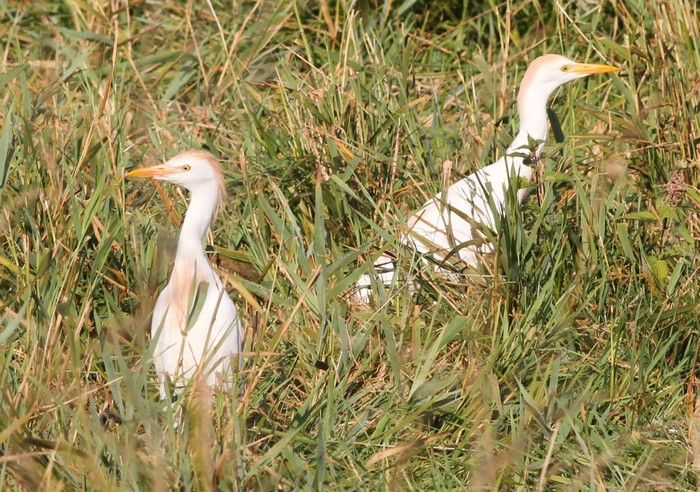
There were four birds at Ham Wall RSPB (Somerset) on 3rd and threes for Lodmoor RSPB (Dorset) on 1st and Leighton Moss RSPB (Lancashire) on 3rd, while two were seen at Shapwick Heath NNR (Somerset) on 1st. A further Somerset bird was seen at Burnham-on-Sea on 3rd, while along the south coast, singles were noted at Angmering (West Sussex) on 1st following on from one past Seaford Head (East Sussex) the previous day.
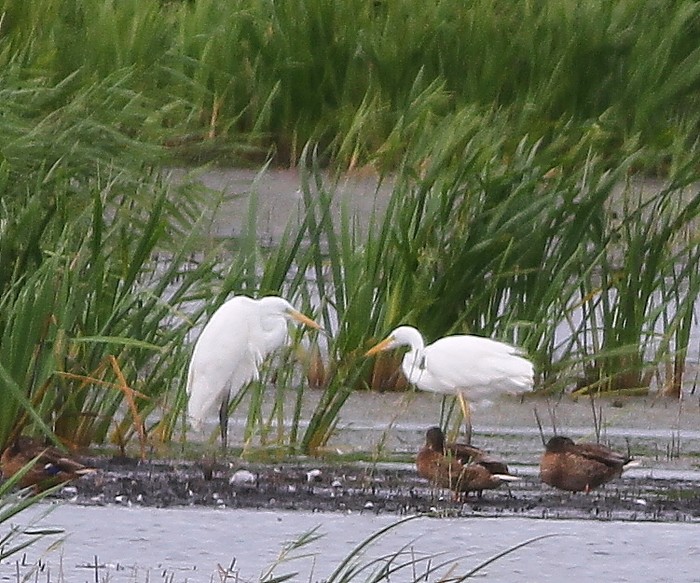
In Kent, a Great White Egret was around Dungeness from 1st while east coast birds included two in Suffolk, at both Lakenheath Fen RSPB and Thorpeness on 3rd, three for Norfolk, at Hickling and over Wells ~ both on 1st ~ and west across Cley on 4th, one or two in East Yorkshire, at Blacktoft Sands RSPB and then North Cave Wetlands YWT (on 2nd and 3rd respectively) with another reported from Alnmouth (Northumberland) on 1st.
Along with the trio around Leighton Moss (sometimes seen from the Eric Morecambe Hide), the northwest of England saw further singles found at Hale (Cheshire) on 1st, Foulridge Reservoir (Lancashire) from 1st-5th and Longtown (Cumbria) on 3rd. Over the border in North Wales, one was at Llyn Brenig (Denbighshire) from 30th-3rd. Inland English birds were seen at Old Moor RSPB, Wombwell Ings and Hatfield Moors (South Yorkshire) between 31st-5th, at Fairburn Ings (West Yorkshire) on 5th, near Uttoxeter (Staffordshire) and Willington GPs (Derbyshire) on 4th, on Ouse Fen (Cambridgeshire) on 5th, over Oxford and then at nearby Farmoor Reservoir on 2nd and in London, over the Ingrebourne Valley on the same date.
Perhaps 12:04 on August 1st is as close as we’ll get to a simultaneous tally of Spoonbills along the north coast of Norfolk ~ within that 60 second period came three separate pager reports offering counts of 17 for Cley, 14 for Stiffkey and 16 for Titchwell ~ a whopping 47 between the three sites, fantastic stuff and an awful lot of cutlery to boot.
Across the week the three sites high counts were: 24 on 4th at Stiffkey, 24 at Cley on 5th and 17, also on 4th, at Titchwell. Norfolk’s only other scoring sites were one for Breydon Water and two for Hickling Broad NWT, all on 30th.
Away from Norfolk but still along the east coast, two Spoonbills moved between Druridge Pools and Cresswell Ponds (Northumberland) early in the week, up to five were noted at Frampton Marsh RSPB (Lincolnshire) on 31st (with another down the coast at Gibraltar Point NNR) and four flew over Minsmere RSPB (Suffolk) on 31st.
Further daaaaahn saaarf, there was one each for Benfleet Creek (Essex) on 4th, Oare Marshes (Kent) on 30th, Pagham Harbour LNR (West Sussex) on 1st with the latter date seeing one head across Wellingborough (Northamptonshire). Numbers for Dorset began to build too ~ seven logged in Poole Harbour on 4th. In Ireland, there was a Spoonbill near Tomhaggard (Co. Wexford) and also still at Quoile Pondage NR (Co. Down) on 1st.
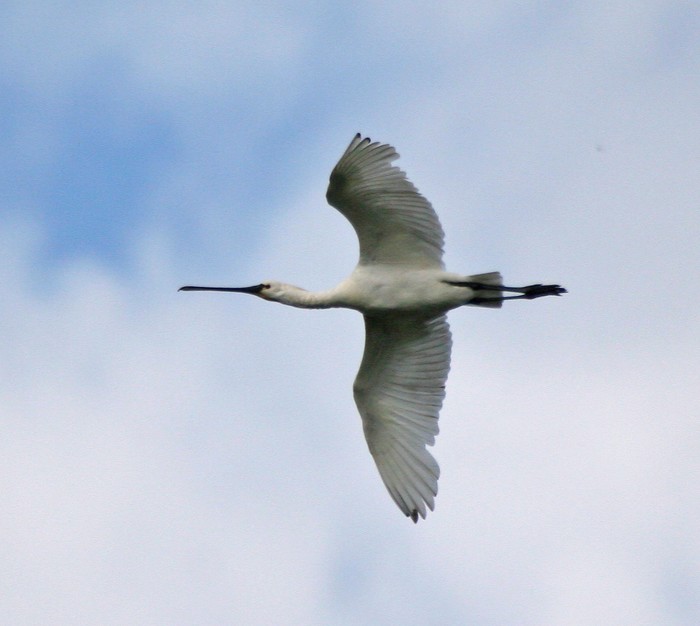
Glossy Ibis next and with no press releases suggesting we’ve had another Med breeder this summer, we’ll wander through the eleven or so single birds that dotted themselves around Britain and Ireland over the past seven days, several of them long-time regulars.
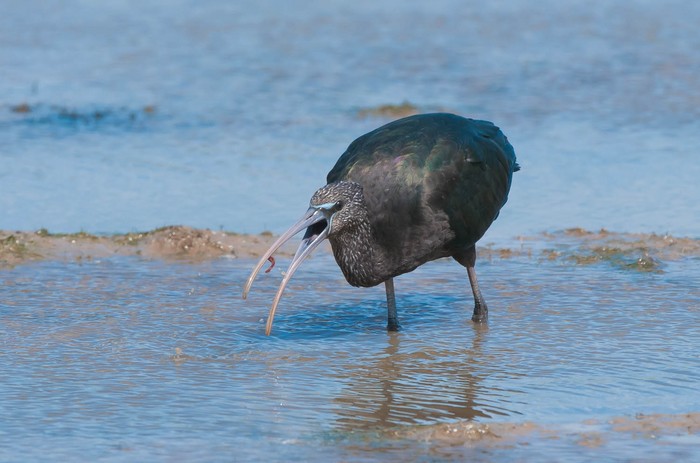
The bird at Berry Fen (Cambridgeshire) was reported to 30th with the same date seeing one (re-)appear at Vane Farm RSPB (Perth & Kinross) (where it remained to 2nd) with the Leicestershire Ibis checking out of Wanlip Meadows (relocating to Cossington Meadows a couple of days later). The final day of July saw singles seen at Beddington SF (London) and also at Lurgangreen (Co. Louth), one of two noted in Ireland this week, the second seen at Ballycotton (Co. Cork) on 2nd. In the northwest of England, a new arrival appeared at Leighton Moss RSPB on 4th heading to Martin Mere WWT the next day with another in West Yorkshire, over Ferrybridge on 5th.
The final quartet was made up of stickers at Old Hall Marshes RSPB (Essex), Milnthorpe (Cumbria) and Frampton Marsh RSPB (Lincolnshire) ~ to 2nd, 3rd and 4th respectively ~ and the reappearing bird Welney WWT (Norfolk) on 2nd-3rd (last seen there on July 20th).
The only Common Cranes this week were two on the Ouse Washes RSPB (Cambridgeshire) to 4th, and twos at Hatfield Moors (South Yorkshire) and Goole Moors (East Yorkshire) on 5th and also in the latter county, the first-summer that was at Arram Carrs and Leven Carrs to 4th.
…with the comedic bent of both Stilt Sandpiper and Great White Egret this week, noted as they were from funnymen hides, I’m now longing for the day when I view a mega or two from the Stewart Lee Hide, the Doug Stanhope Hide or the Louis C.K. Hide…anyone of those days would be genuinely funny…c’mon RSPB and Wildlife Trusts, tap them up….make my day.
The family of two adults and two young Spotted Crakes performed at Burton Mere RSPB (Cheshire) on 31st, with reports of a single adult and an occasional youngster to the end of the review period. The often hyperactive adult at Titchwell RSPB (Norfolk) performed well to 4th and another was reported from the other end of the county, at Strumpshaw Fen RSPB, on 2nd. The second new bird of the week was found at Rye Meads RSPB (Hertfordshire) on 30th with the third arriving at Rainham Marshes RSPB (London) on 4th-5th.
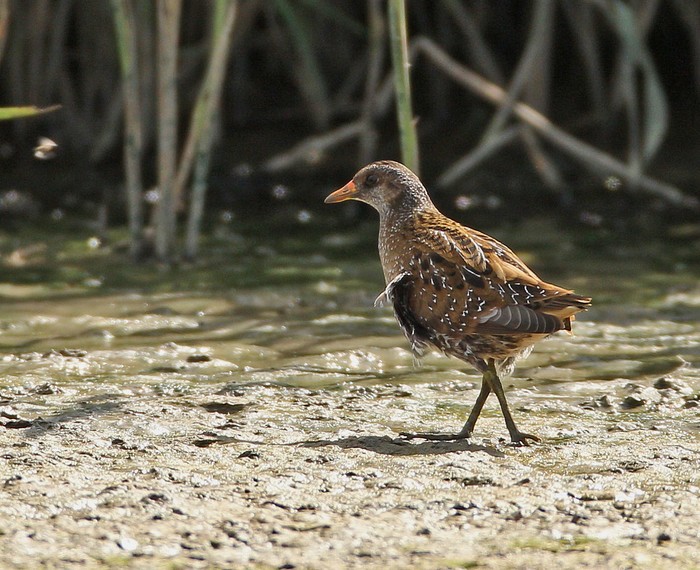
In Ireland, a migrating Corncrake was seen at Boley Hill (Co. Wexford) on 5th.
The same three Surf Scoters ~ two males and a female ~ lingered off Blackdog (Aberdeenshire) to 3rd at least, with a lone drake still present there on 1st.
As with recent reviews, there was little to offer by way of wild ducks ~ a drake Lesser Scaup was found on Blagdon Lake (Somerset) on 4th while the eclipse drake Ring-necked Duck at Murton GPs (Angus) was the only other quacker of note.
In Essex, a Pratincole sp., flew over Howlands Marsh NR on 2nd ~ with a couple of species to choose from on our side of the North Sea of late its hard to guess what the colour of the underwing may have been, but with several Black-wingeds recently in the Netherlands, perhaps that offers a clue (though Suffolk had a Collared until recently too…). All that besides, it hasn’t been seen again, so we’ll never know what was what.
No new Pacific Golden Plovers this week, but both of the birds that appeared last week stuck it out in their respective haunts for a little while longer. The first for Staffordshire remained at Middleton Lakes RSPB, near Drayton Bassett until sometime during the afternoon of 2nd while on Orkney, the North Ronaldsay adult fulva remained all week long.
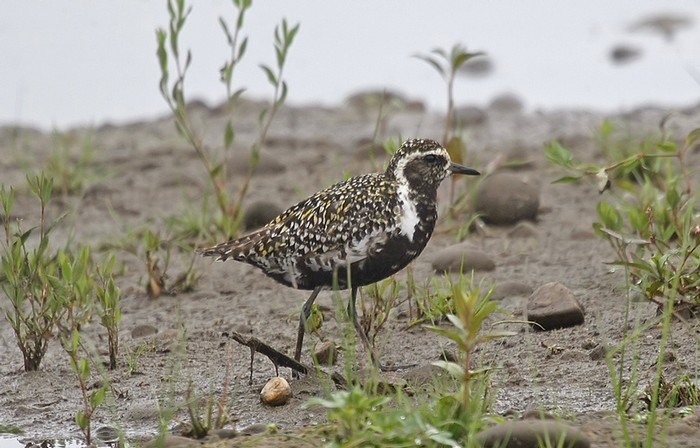
Shetland’s White-rumped Sandpiper was last seen at the Pool of Virkie, at the south end of Mainland, on the 30th when an adult was again noted at Gibraltar Point NNR (Lincolnshire). The following day, an adult was found a little way across The Wash, at Snettisham RSPB (Norfolk) where it remained to 1st. Back in Lincolnshire on 2nd, an adult White-rumped was found at Frampton Marsh RSPB, where it stayed to 5th. Norfolk’s undeniable second of the week was found on Rush Hills Scrape, Hickling on 1st and was still present to 3rd.
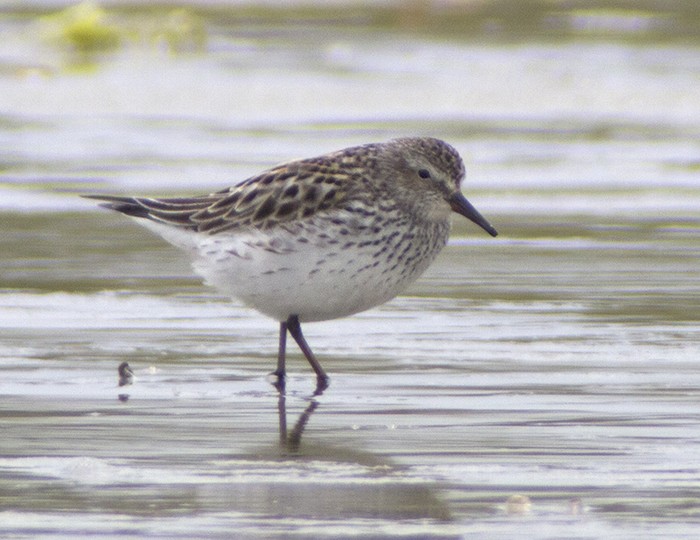
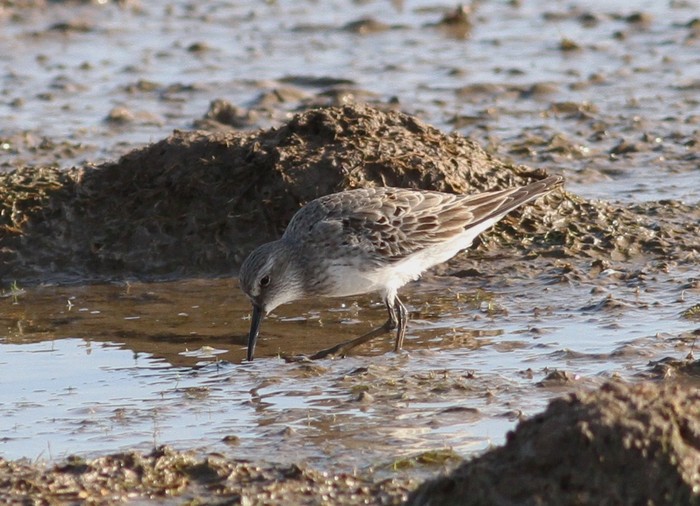
Four new Pectoral Sandpipers made landfall this week ~ the first was found at Loch of Stathbeg RSPB (Aberdeenshire) on 31st and was followed by discoveries on 1st at Pennington Marshes (Hampshire) and Carr Lane Pools, Hale (Cheshire) and at Haroldswick, Unst (Shetland) on 4th.
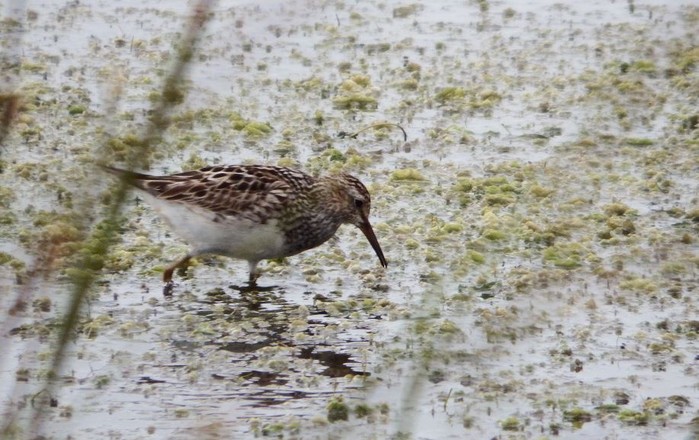
Hot on the heels of the flyover (flying off and away...) Black-winged Pratincole near Seaford comes news of a flyover Dotterel on 31st, the sole record of the month. Two Temminck’s Stints managed to make it to the review this week ~ the first was at Stow Marsh (Essex) on 30th with the second arriving at Cley Marshes NWT on 2nd and was still present to 4th.
The Medmerry family of Black-winged Stilts were in situ at the natal site until 30th (a maximum of three noted that day) and had moved a couple of miles to Sidlesham Ferry by the next morning, remaining there until 2nd. By the morning of 3rd, they’d hopped further along the West Sussex coast once again, this time alighting at Pulborough Brooks RSPB and they remained there to 5th.
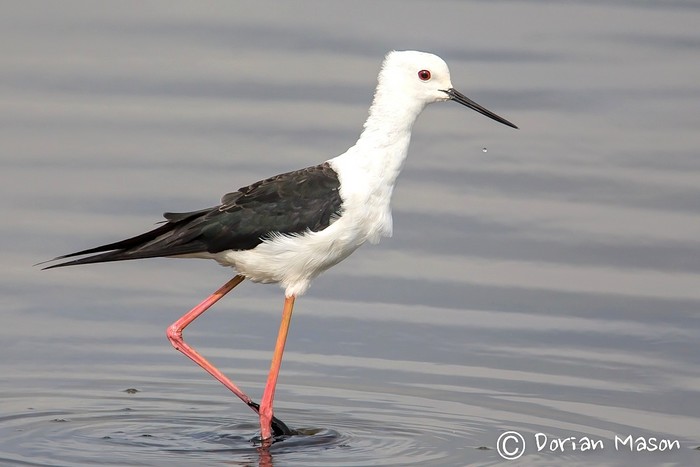
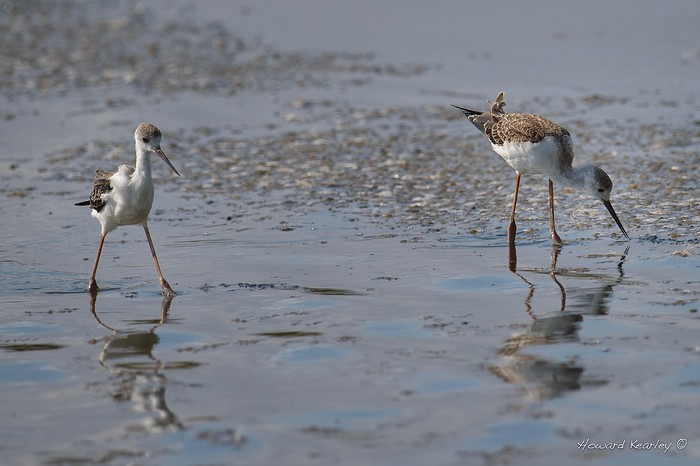
After a brief sortie across Livermere at the end of last week’s review period, three of the Suffolk family of Black-winged Stilts were again at Cavenham Pits on 30th (an adult with two juveniles) which was the final sighting at their favoured (breeding?) site (or was it? The family of six were reported there again on 2nd). After no records for a few days, the female reappeared at Great Livermere on 3rd.
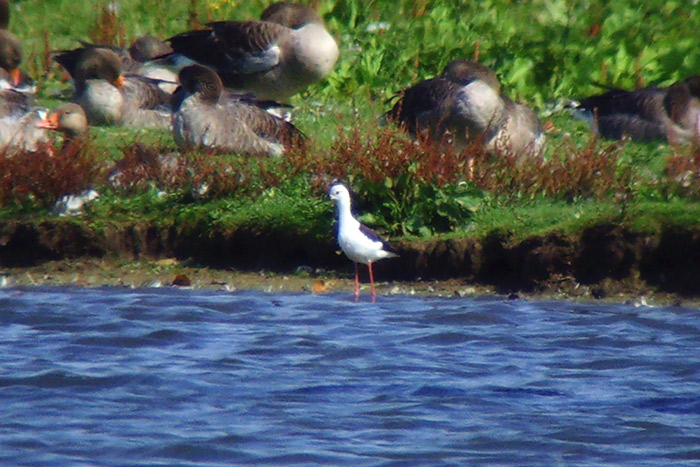
As well as our breeding birds, a new lone Black-winged Stilt was found in Hampshire, heading east over Blashford Lakes HWT on the evening of 2nd ~ the second this year in the county after a spring female was found at Titchfield Haven.
Those long-time regulars at the far east end of Norfolk have really been enjoying themselves around the vast surrounds of Breydon Water so far this summer. Not content with popping in a first for Norfolk and Suffolk ~ in the form of that pesky Big Knot ~ this week saw another top notch Norfolk rare chalked up on the Breydon board ~ Franklin’s Gull.
This rather scruffy indivdiual (a second-summer type or maybe a rather tatty adult?) was discovered not by one of Breydon’s old-hands but by a one-time “Punk” (you were some 25 years too late in the first place gentlemen...barely even qualifying as the NWONW ~ while we’re on the subject, check out the immense eponymous EP from S*M*A*S*H...it’s what speakers were invented for...) who is now firmly rooted in the Establishment (just like a lot of old-time punks are I suppose).
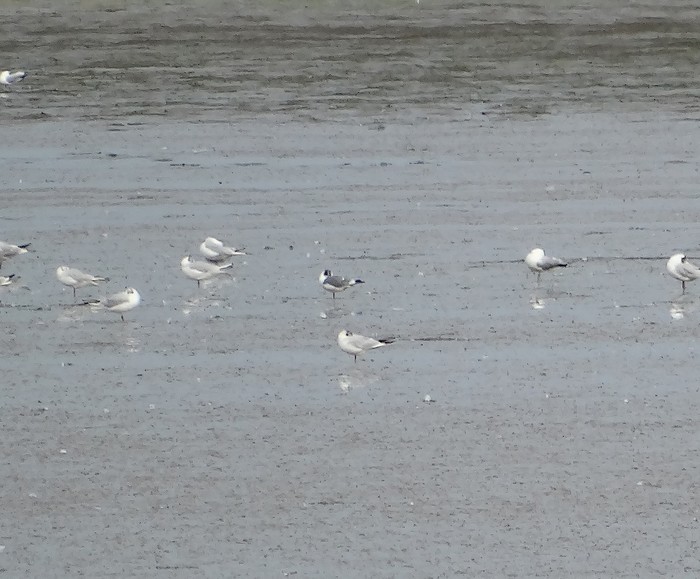
Whether he’s more Captain Sensible than Steve Ignorant is no matter, as it’s top finding once again from James Gilroy ~ becoming Norfolk’s fourth Franklin’s Gull in to the bargain ~ with the quartet of sightings shared between just two sights to date.
Breydon regular Keith Dye found the first Norfolk bird on June 30th 1991 and it was followed a year later by a brief adult at Titchwell, on July 21st 1992. Titchwell recorded Norfolk’s third one-day bird on May 10th 1998, a first-summer bird that was seen, amazingly, alongside a Laughing Gull in the same gull colony.The 1998 Franklin’s was seen two days later in Lincolnshire and, two days after that, in Shetland ~ a significant distance, but no great shakes for a bird that heads two and fro with a prairie wind up its tail way down to South America and back every spring and autumn.
Now Breydon has sandwiched those two Titchwell records, to make it two records a piece. This week’s bird headed north after just a couple of hours on site...destination unknown.
Leaving the why’s and wherefore’s of when punk became new wave and the “who’s better” Ramones vs New York Dolls and Pistols vs Clash arguments behind us (well, behind me if no one else, at least the Gilroy find has ~ by a supremely convoluted twist ~ made me turn back again towards music that isn’t rooted in a hoary old Canuck and his Crazy Horse), we’ll whisk our way from east Norfolk to southwest Ireland where all such musical nonsense has no bearing on the matter in hand which is actually to report the continuing presence of the first-summer Laughing Gull at Ballycotton, still on site to 4th.
Looking increasingly forlorn in an ugly duckling kind of a way was the bleached, abraded and worn first-summer Ross’s Gull that stuck it out along the Exe Estuary near Topsham for a few more days to 2nd. Fear not though as one day, you’ll turn in to the most exquisite of all gulls...
The Kentish Bonaparte’s Gull showed well between 30th-3rd at Oare Marshes while the Nearctic quartet is completed by an adult Ring-billed Gull on Nimmo’s Pier (Co. Galway) on 2nd.
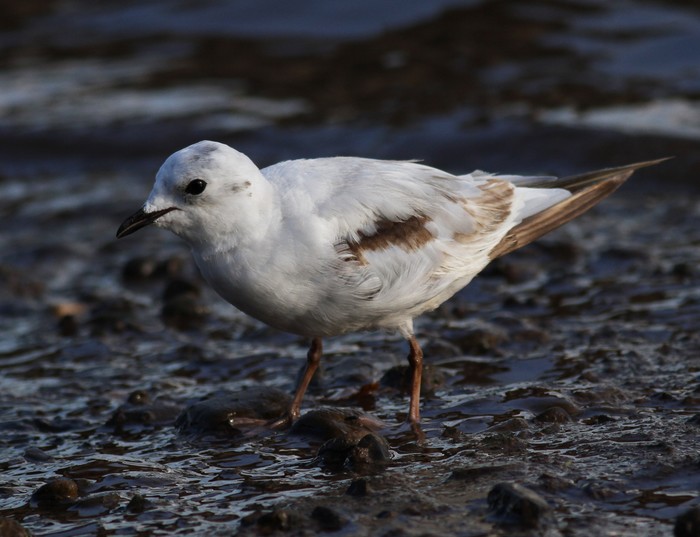
The only Glaucous Gull was seen heading east past Birsay (Orkney) on 4th. A candidate first-summer Baltic Gull in Shropshire early in the week apparently didn’t quite past muster, while Suffolk remained at the forefront of the Caspian Gull action, maybe as many as 14 or 15 in the county through the week, including six at Great Livermere on 1st and five (an adult, a second-summer, two first-summers and a juvenile) at Walberswick, also on 1st.
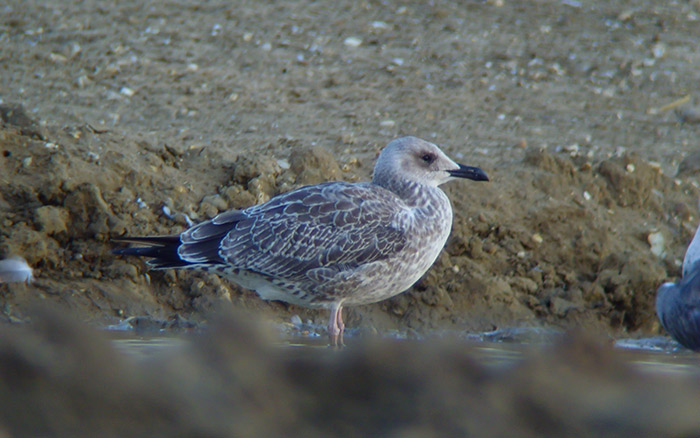
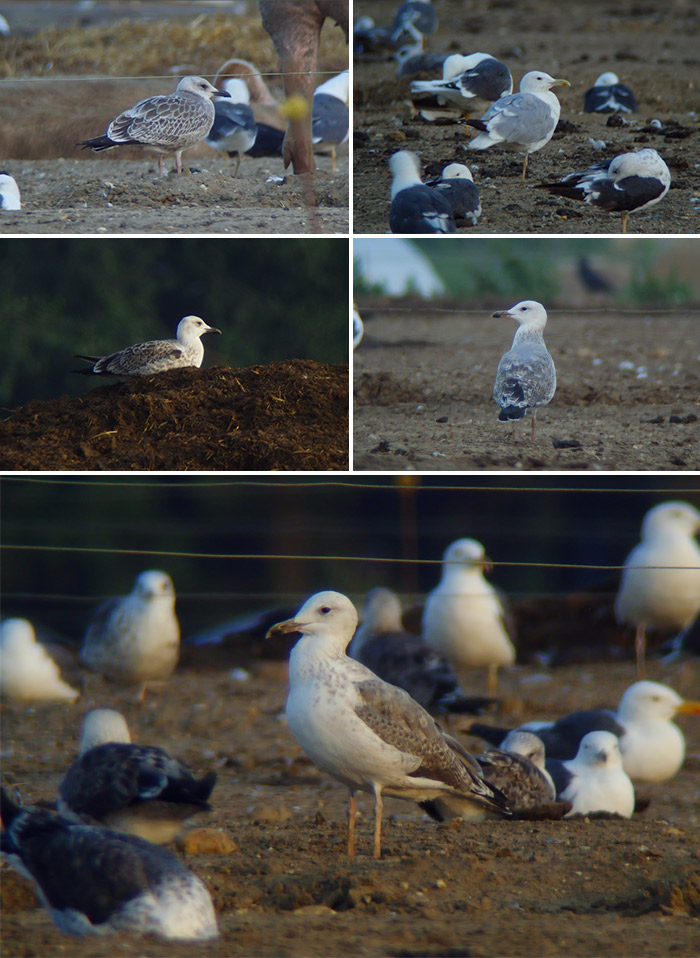
Two adults and a third-summer were on Cley’s North Scrape on the damp evening of 31st and the reserve’s fourth of the week, a Polish-ringed adult appeared on Simmonds’ Scrape on 2nd-3rd. Cley’s fifth and six followed on the evening of 4th with a new adult and new juvenile appearing on Simmonds’ Scrape. Further cachinnans records came from Stanwick GPs (Northamptonshire) on 30th and Idle Valley NR (Nottinghamshire) on 1st (both single adults) with a new juvenile in the roost at Grafham Water (Cambridgeshire) on 3rd.
Finally for this section comes news of a Caspian Tern at Exmouth (Devon) on 5th ~ the second of the year so far (after one on Shetland in early June) and just the third record for the county ~ the only records to date being one on the Axe Estuary on July 6th 1966 and, most recently, at Dawlish Warren on July 27th 2004. A rare bird indeed for the southwest...what a great find.
Norfolk accounted for two reports of Black Kite this week ~ one was mentioned heading over Stiffkey Fen on 31st with another claimed over the local garden centre in Fakenham, heading towards Sculthorpe Moor on 1st. A third was reported from Essex, near Colchester on 3rd while the Plastic Fantastic ringed escape remained in Suffolk to 2nd, landing on the playing field at Wrentham (well it makes a change from the duff Buffleheads and Hooded Mergansers we endure throughout the seasons doesn’t it ~ what what!)
In Kent, roaming Honey Buzzards were seen over Ramsgate (Kent) on 30th with two over Bockhill Farm, St. Margaret’s at Cliffe on 4th, while in Notts., a single bird was again at the Welbeck Raptor Viewpoint on the same date with another at Budby on 2nd. Across in Lincolnshire, a ringtail Montagu’s Harrier was a sporadic visitor to Gibraltar Point NNR between 31st-4th and another ringtail was found at Tacumshin (Co. Wexford) on 5th.
Two non-adult Red-footed Falcons were noted this week ~ a first-summer female was at Minsmere RSPB (Suffolk) on 31st and a sub-adult was on wires near Tacumshin (Co. Wexford) on 2nd, the first record in the county for a couple of years.
As the curtain came down on the evening of 5th, news emerged from a southeast wind bathed Shetland of Britain’s first August Rustic Bunting, found at Halligarth, Unst.
When the species was removed from the Rarities List nine years ago, the total was on 448 accepted records. Annual numbers since have fluctuated ~ some years it has been particularly rare ~ but there’s never been an August one yet. Before 2005, the earliest autumn record was of two birds on Holy Island (Northumberland) on September 1st 1966.
Another surprise Shetland bird on 5th was an early Barred Warbler on Fair Isle. Whatever’s coming next?
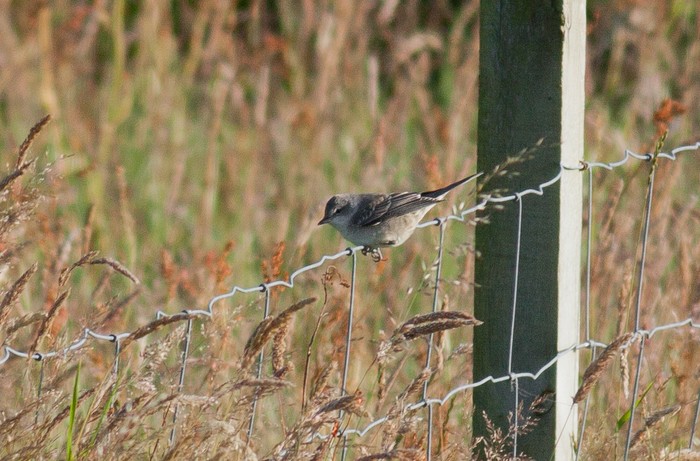
With a warm southwest wind breezing along the south coast as the weekend approached, there was one species that was surely going to make itself known and, right on cue, the Obs., staff at Portland duly obliged with a Melodious Warbler on the afternoon of 2nd. Earlier the same day, a Hippolais sp., was found on St. Mary’s (Scilly), but couldn’t be assigned to species. A couple of days later on the same island, a confirmed Melodious was found at Carn Friars.
Not far down the road from Portland (and also on 2nd) came a report of a Hoopoe at Lodmoor RSPB ~ but after the first news came “no further sign”.
A spring well-inland male Red-backed Shrike would be a surprise find, so the discovery of one in Buckinghamshire on July 30th raised eyebrows (particularly those of local listers) further still when a male was found at Quainton Hill on 30th. The first in the Home County since a juvenile in September 2005, this popular male remained faithful to the hawthorn hedge to 4th. A second male was found at Baston Fen (Lincolnshire) on 2nd, another very tidy summer discovery.
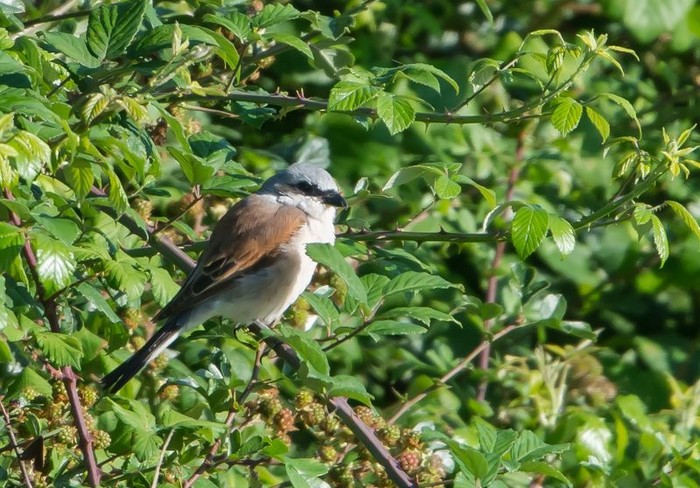
After the excitement of last week’s news of breeding Bee-eaters on the Isle of Wight, things haven’t been running as smoothly over the past few days. The last mention of the two young came on 31st and since then the only news coming from the Wydcombe Estate NT watchpoint has specifically referred to adults only ~ including four reported there on 2nd. Three adults remained to 4th with two there on 5th, but the hopes of fledging juveniles popping out of the burrow appears a little less likely, but hopefully its just a news-lull in the proceedings.
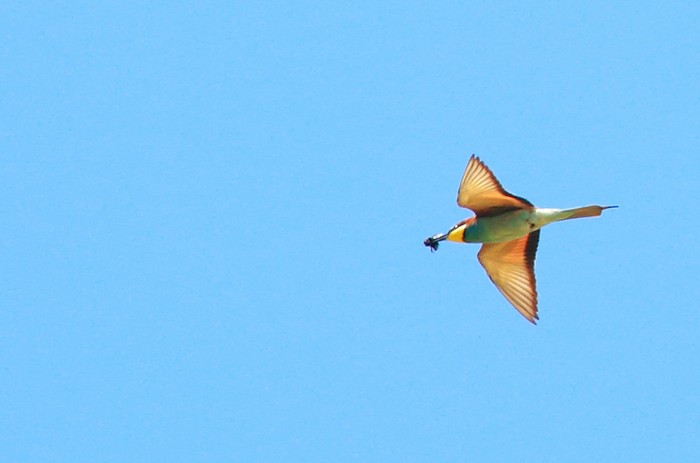
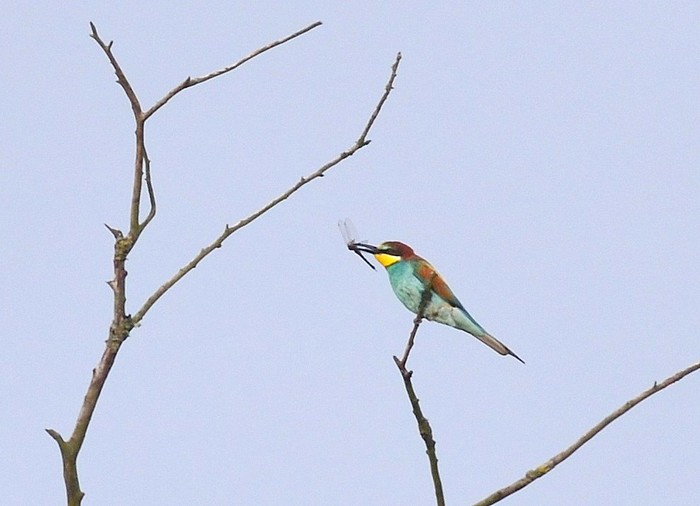
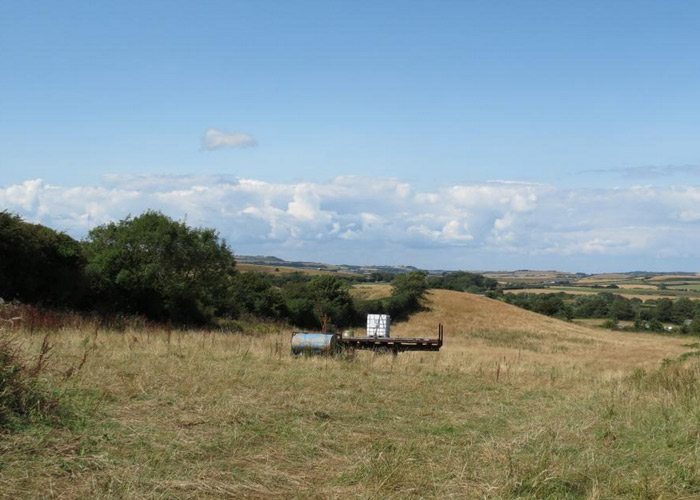
Another Bee-eater was seen heading north over Sea Palling (Norfolk) on the early morning of 3rd and two were found near Basildon (Essex) on 4th.
So what about the week ahead?
Seabirds, especially rarer petrels and shearwaters, must remain firmly on the agenda, especially as the remnants of Hurricane Big Bertha are supposed to be heading this way sometime around Sunday (10tH) ~ with the right weather, we’re on for the first reports of Little and Yelkouan any day now (the latter in a precarious position here at present…) and what odds on an Irish or Cornish headland laying claim to a land-based Bermuda Petrel before too long? If there’s a Mega Alert this week, a west coast seabird is going to be the culprit…
Shorebirds will remain at the forefront of most people’s thoughts too across the next few days ~ if you fancy finding a Sharp-tailed Sandpiper try August 6th (three have been found on that date…) and there’s been one more too later in the week. Far less rare but always appreciated, the tropical blow may favour the first Semipalmated or Buff-breasted Sandpipers of the autumn. Or maybe a nice early Wilson’s Phalarope…
The incredible Nutcracker invasion of August 1968 got under way in the week ahead ~ 19 birds logged between August 6th-12th of that year (well over 100 appeared through the month) and with the last accepted bird coming a full 16 years ago (minus a month), there’s many folk with fingers crossed that one of these bad boys will rock up soon.
We’re also up to the annual mention of our last record of a species that barely ever gets a mention in the Land of Forums and Cyberspace. Rufous Bush Chat.
Eleven records were been spread across Britain and Ireland between the first, shot near Brighton in September 1854 and the last, seen at Prawle Point on August 9th 1980. With not a whiff or sniff of one since, the wait goes on and on as thoughts that its even on the British List fades with each year that has passed across the last 34 years. Interestingly, the last three records came within a 12 year period (Devon in 1980, East Yorkshire in 1972 and Cape Clear Island in 1968) ~ an average of one every four years wouldn’t have seemed so bad. In stark contrast, none in 34 years is very bad indeed…
…but finally to a species we may all just catch up with soon…Eleonora’s Falcon. These days, there’s barely a year that’s passes without a report or two of this stunning raptor but the most recently accepted bird was seen just a couple of years ago ~ the photographed dark-phase first-summer over the cliffs at Porthgwarra on August 11th 2012 gave hope to everyone, becoming the 7th accepted record.
…and the 1st? That was also found in the week ahead ~ present at Formby Point on August 8th-9th in (I love it when things fall in to place…) 1977 ~ the year that punk reigned supreme! (Tho’ it was Donna Summer’s awesome killer disco cut “I Feel Love” that was Number 1 when a handful of folk were getting to grips with Britain’s first-ever Ellie’s ~ ok pop-pickers?).
When the first twitchable one will come along is one of many birding “Million $ Questions”. It could come quicker than you think.
Mark Golley
06 Aug 2014
A special thanks this week to Lee Gregory for his Caspian Gull images. Bob Flood and Scilly pelagics for the gripping YouTube clips of the wildlife noted across the past few days. For more information on trips and publications, check out www.scillypelagics.com
Thanks also all our other contributors for their photos, videos and sound recordings.












